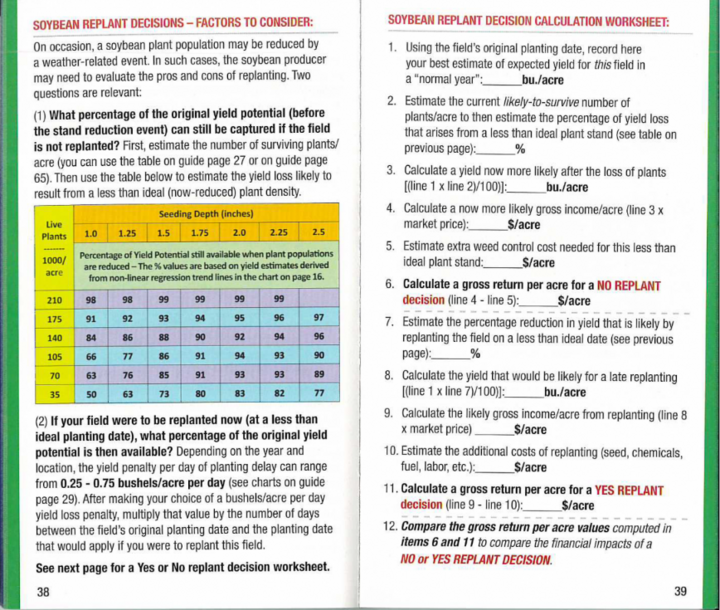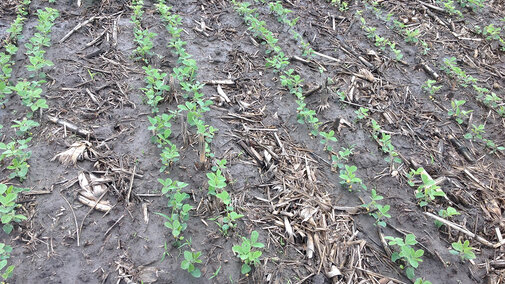With the recent frost events that occurred the weekend of May 9-10, 2020 in portions of the State, some are questioning the need to replant soybean. It’s important to assess potential recovery before making replant decisions. Soybeans are more resilient than one may think! Please see Evaluating Freeze and Chilling Injury to Corn and Soybeans for more information.
The following weather data was provided by Al Dutcher.
The following information was shared as part of a June 14, 2019 article entitled “Considerations after Crusted Soybean” by authors Jenny Rees, Jim Specht, Roger Elmore, Aaron Nygren, and Nathan Mueller. Research links have been updated for 2020. While that article was regarding crusting issues, the research and information can apply to many factors that can contribute to reduced soybean stands such as the freezing temperatures experienced this year.
Key Points:
- For optimum yields and economics based on soybean population studies for 13 years, we have recommended a final plant stand of 100,000 plants per acre.
- Soybeans compensate for reduced stands through increased branching. Based on research and observations, we recommend leaving an early planted soybean stand of at least 50,000 plants per acre that has fairly uniform spacing throughout the field. We realize that can be hard! University of Wisconsin found only a 2 bu/ac yield increase when replanting early soybeans between 50,000 and their optimum stand of 100,000-135,000 plants/acre.
- For stands less than 50,000 plants per acre, plant a similar maturity into the existing stand; don’t tear out or kill an existing stand as early planted soybeans have a higher yield potential.
- If you’d like to test this for yourself, consider an on-farm research study! Simply leave a planter pass of your existing stand, plant into your existing stand for a planter pass, and alternate this across your field. Please see this protocol for more information.
Research with Low Populations
Soybeans greatly compensate for reduced populations by increasing branching. Nebraska On-Farm Research from eastern Nebraska and western Nebraska for 12 years of combined data showed only a 1.3 bu/ac yield increase when seeding 180,000 soybean seeds/acre compared to 90,000 seeds/acre in 15-inch or 30-inch rows. (No studies were in sandy soils). Average final plant stands became 154,924 vs. 83,067 plants per acre respectively. Updated 2020 research information can be found in this CropWatch article. Specific examples with lower final plant stands follow:
- A non-irrigated field in Nuckolls County in 2006 was hailed at the cotyledon stage, so planted populations of 100K, 130K, and 160K became average actual stands of 74,417; 89,417; and 97,917 plants per acre with a 4 bu/ac yield difference between highest and lowest plant populations. The average yield in the field was 40 bu/ac.
- An irrigated field in Hamilton County in 2010 showed a 3 bu/ac yield difference between planted stands of 80K versus 120K seeds/acre. Final plant stands weren’t taken.
- A York County irrigated field in 2018 comparing 90K, 120K, and 150K became final plant stands of 60,875, 88,125, and 121,750 plants/acre with yields of 93, 94, and 97 bu/ac respectively.
As you assess plant stands, keep in mind that a gap in one plant row will be compensated by plants in the adjacent flanking rows. They will form extra branches to take advantage of the sunlight. Thus single-row gaps may not be as yield-reducing as you might think, especially in narrower row spacings.
Replant Considerations
Any anticipated yield loss from the reduced stand must be balanced against the anticipated yield loss from replanting after the optimum planting date. Nebraska research has consistently shown the benefit of early soybean planting for higher yields. This is mainly due to node accrual on the main stem which allows for an increased potential for pods and seeds compared to planting later. Thus, replanting may not out-yield the original planted stand even at lower plant populations. Thorough scouting on foot or ATV and taking numerous counts may help pinpoint certain areas within a field to spot in/replant a portion of the field instead of the entire field.
Weed control is another factor, depending on the time of year, for soybean replant consideration. Leaving a poor stand may result in poor weed control or increased herbicide costs. Replanting may entail additional costs for seed, tillage, and replanting in addition to the potential yield penalty imposed by a later-than-normal planting date. We also recommend a fungicide seed treatment when replanting soybean.

When in doubt, consider testing this for yourself! Leave checks in your field that can be compared to where you replant. You can also consider this as an on-farm research study by contacting your local Extension Educator like a grower in Platte County did in 2014. He originally planted 145,000 seeds/acre on May 10 no-till into heavy corn residue. With a plant stand of 75,000 plants per acre, he chose to replant soybeans in strips across the field. He left the original stand and planted an additional 145,000 seeds/acre. Final yields were 58 and 57 bu/ac for the original and replanted stand, respectively.
For more information, see the “Soybean Replant Decision Calculation Worksheet” on page 39 in the Nebraska Soybean & Corn Pocket Field Guide.

